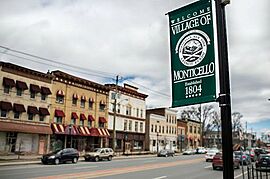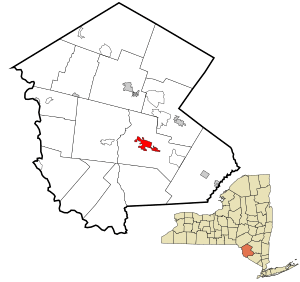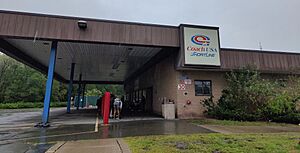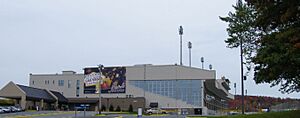Monticello, New York facts for kids
Quick facts for kids
Monticello, New York
|
|
|---|---|
|
Village
|
|
| Village of Monticello | |

An image of the Broadway district in Monticello
|
|
| Nickname(s):
Gateway to the Catskills
|
|

Location of Monticello in Sullivan County, New York
|
|
| Country | United States |
| State | New York |
| County | Sullivan |
| Town | Thompson |
| Established | 1804 |
| Incorporated | 1830 |
| Area | |
| • Total | 4.11 sq mi (10.63 km2) |
| • Land | 4.08 sq mi (10.57 km2) |
| • Water | 0.02 sq mi (0.06 km2) |
| Elevation | 1,512 ft (461 m) |
| Population
(2020)
|
|
| • Total | 7,173 |
| • Estimate
(2021)
|
7,332 |
| • Density | 1,757.66/sq mi (678.57/km2) |
| Time zone | UTC-5 (EST) |
| • Summer (DST) | UTC-4 (EDT) |
| ZIP codes |
12701
|
| Area code(s) | 845 |
| FIPS code | 36-48175 |
| GNIS feature ID | 0957561 |
Monticello (![]() i/ˌmɒntɪˈsɛloʊ/ MON-tiss-EL-oh) is a village in Thompson, Sullivan County, New York, United States. It's located in the beautiful Catskills region. Monticello is the main town for Thompson and the county seat of Sullivan County. This means it's where the county government offices are.
i/ˌmɒntɪˈsɛloʊ/ MON-tiss-EL-oh) is a village in Thompson, Sullivan County, New York, United States. It's located in the beautiful Catskills region. Monticello is the main town for Thompson and the county seat of Sullivan County. This means it's where the county government offices are.
In 2020, about 7,173 people lived here. The village was named after the home of Thomas Jefferson, who was a very important person in American history. Monticello is the biggest village in Sullivan County, both in how many people live there and how much land it covers. It's also about halfway between Binghamton, New York and New York City along New York Route 17.
Contents
History of Monticello
How Monticello Began
In 1801, a man named Samuel F. Jones was looking for a path for a new road. This road, called the Newburgh and Cochecton Turnpike, would connect the Hudson and Delaware Rivers. As he explored, Samuel saw a great spot to build a village right on this new road.
He convinced his younger brother, John Patterson Jones, to buy a large piece of land, about 1,861 acres. This land would be split by the new turnpike. In 1803, John and eleven other men started working. They built a sawmill and other things needed to start a village.
The group left for the winter but came back in early 1804 to keep working. By the spring of that year, the road's path was set. The two brothers then planned out the village. The first tree for the village was cut down by John on September 4, 1804. This was on the land where his house would later be built. The village grew quickly, having 20 houses by 1813. It officially became a village on April 20, 1830.
The Great Fire of 1909
On the evening of August 10, 1909, a big fire broke out in Monticello's Broadway district. The fire started at a local power station. It quickly spread, burning many buildings along Broadway street. Local fire departments rushed to the scene. They worked fast to stop the fire from spreading to homes.
When the fire was finally out, 40 buildings were destroyed. This caused about $1 million in damages, which was a huge amount of money back then. Luckily, no one died in the fire. The village soon rebuilt itself.
Monticello's Location and Landscape
Monticello is located at 41°39′N 74°41′W / 41.650°N 74.683°W. It is part of the Catskill Mountains region in New York. The village covers about 4.1 square miles (10.6 square kilometers) of land.
Monticello is a central spot in the region. It's about 80 miles (129 km) northeast of Scranton, Pennsylvania. It's also about 90 miles (145 km) southeast of Binghamton. If you travel northwest, it's about 85 miles (137 km) from New York City.
People of Monticello
Monticello is home to a diverse community. In 2000, there were 6,512 people living in the village. The population density was about 1,601 people per square mile (618 people per square kilometer).
The village has many families and individuals. About 31.7% of households had children under 18. The average household had 2.39 people. The average family had 3.14 people. The median age in the village was 35 years old.
| Historical population | |||
|---|---|---|---|
| Census | Pop. | %± | |
| 1870 | 912 | — | |
| 1880 | 941 | 3.2% | |
| 1890 | 1,016 | 8.0% | |
| 1900 | 1,160 | 14.2% | |
| 1910 | 1,941 | 67.3% | |
| 1920 | 2,330 | 20.0% | |
| 1930 | 3,450 | 48.1% | |
| 1940 | 3,737 | 8.3% | |
| 1950 | 4,223 | 13.0% | |
| 1960 | 5,222 | 23.7% | |
| 1970 | 5,991 | 14.7% | |
| 1980 | 6,306 | 5.3% | |
| 1990 | 6,597 | 4.6% | |
| 2000 | 6,512 | −1.3% | |
| 2010 | 6,726 | 3.3% | |
| 2020 | 7,173 | 6.6% | |
| 2021 (est.) | 7,332 | 9.0% | |
| U.S. Decennial Census | |||
Schools in Monticello
The Monticello Central School District runs several schools for students of all ages:
- Project Excel: This is a preschool program.
- George L. Cooke Elementary School: For students in Kindergarten through 2nd grade.
- Kenneth L. Rutherford Elementary School: For students in 3rd through 5th grade.
- Emma C. Chase Elementary School: Also for students in Kindergarten through 5th grade.
- Robert J. Kaiser Middle School: For students in 6th through 8th grade.
- Monticello High School: For older students in 9th through 12th grade.
Media and Local News
Monticello has its own radio station, WSUL 98.3 FM. This station plays Adult Contemporary music and is very popular in Sullivan County. Other local stations include WVOS 1240 AM and WVOS-FM 95.9 FM, which are based in the Village of Liberty. Another station, Thunder 102.1 Thunder Country, has also moved to Monticello.
Getting Around Monticello
Monticello is located right next to New York State Route 17. This road is often called the "Quickway" and will eventually become Interstate 86. Monticello is also where New York State Route 17B begins. New York State Route 42 also passes through the area, running north and south.
The local bus station is a hub for the region. It is served by Coach USA Short Line buses. There is also a local bus service provided by Sullivan County Transportation. This service runs once a week on two different routes.
Years ago, the New York, Ontario & Western Railway had a train line to Monticello. Many people used it until after World War II. Then, more people started using cars, and the train line was closed on March 30, 1957.
Fun Things to Do in Monticello
Monticello is well-known for the Monticello Raceway. In the past, this raceway attracted many people from all over the northeast. Today, the Raceway is also a "racino." This means it has electronic slot machines in addition to horse racing. However, the casino part of Monticello Casino and Raceway closed in 2019, so now it's mainly for horse racing.
Just seven miles (11 km) from the Raceway is the Bethel Woods Center for the Arts. This is a very famous place because it was the site of the 1969 Woodstock Festival. If you like car racing, the Monticello Motor Club is also nearby. A large casino, hotel, and spa called Resorts World Catskills opened in February 2018. It is located near the old Concord Resort property.
Monticello was once the center of what people called the "Borscht Belt." This area was famous for its huge Jewish resorts. These included the Concord and Grossinger's resorts, among many others. Only a few of these resorts lasted into the 21st century. Kutsher's Hotel was one of the last to close. Today, only the Raleigh Hotel is still open.
Famous People from Monticello
Many notable people have connections to Monticello:
- Stephanie Blythe: A famous opera singer.
- Lawrence H. Cooke: A former Chief Judge of the New York State Court of Appeals. The Sullivan County courthouse lawn has a monument dedicated to him.
- Stanley Finch: The very first director of the Bureau of Investigation, which is now known as the FBI.
- Robert S. Kapito: A co-founder and president of Blackrock, a large investment company.
- Judith Kaye: Another former Chief Judge of the New York State Court of Appeals.
- Ivan C. Lafayette (1930–2016): A politician.
- Catello Manzi: A skilled harness racing driver.
- Elisabeth Worth Muller: A suffragist and clubwoman.
- Daniel Bennett St. John: One of the original owners of The New York Times newspaper.
Places of Worship
- Chevro Ahavath Zion Synagogue
- Iglesia de Dios - Amor & Fe (Church of God Love & Faith) - This church offers services in both Spanish and English.
See also
 In Spanish: Monticello (Nueva York) para niños
In Spanish: Monticello (Nueva York) para niños



